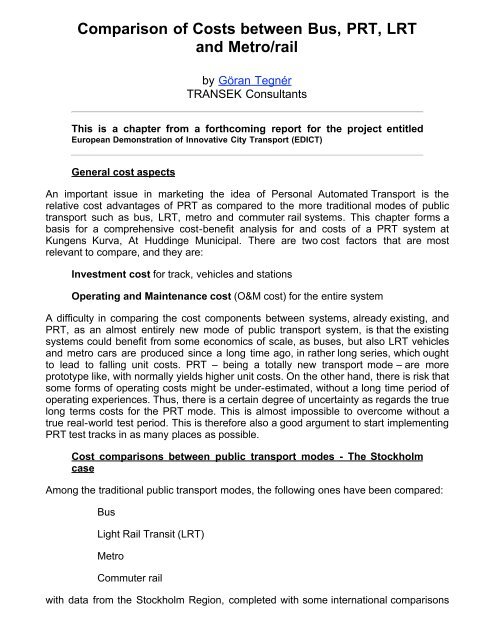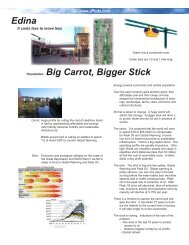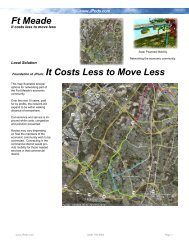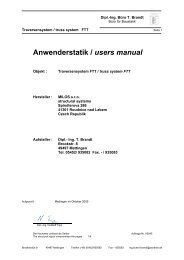Comparison of Costs between Bus, PRT, LRT and Metro/rail - JPods
Comparison of Costs between Bus, PRT, LRT and Metro/rail - JPods
Comparison of Costs between Bus, PRT, LRT and Metro/rail - JPods
You also want an ePaper? Increase the reach of your titles
YUMPU automatically turns print PDFs into web optimized ePapers that Google loves.
<strong>Comparison</strong> <strong>of</strong> <strong>Costs</strong> <strong>between</strong> <strong>Bus</strong>, <strong>PRT</strong>, <strong>LRT</strong><br />
<strong>and</strong> <strong>Metro</strong>/<strong>rail</strong><br />
by Göran Tegnér<br />
TRANSEK Consultants<br />
This is a chapter from a forthcoming report for the project entitled<br />
European Demonstration <strong>of</strong> Innovative City Transport (EDICT)<br />
General cost aspects<br />
An important issue in marketing the idea <strong>of</strong> Personal Automated Transport is the<br />
relative cost advantages <strong>of</strong> <strong>PRT</strong> as compared to the more traditional modes <strong>of</strong> public<br />
transport such as bus, <strong>LRT</strong>, metro <strong>and</strong> commuter <strong>rail</strong> systems. This chapter forms a<br />
basis for a comprehensive cost-benefit analysis for <strong>and</strong> costs <strong>of</strong> a <strong>PRT</strong> system at<br />
Kungens Kurva, At Huddinge Municipal. There are two cost factors that are most<br />
relevant to compare, <strong>and</strong> they are:<br />
Investment cost for track, vehicles <strong>and</strong> stations<br />
Operating <strong>and</strong> Maintenance cost (O&M cost) for the entire system<br />
A difficulty in comparing the cost components <strong>between</strong> systems, already existing, <strong>and</strong><br />
<strong>PRT</strong>, as an almost entirely new mode <strong>of</strong> public transport system, is that the existing<br />
systems could benefit from some economics <strong>of</strong> scale, as buses, but also <strong>LRT</strong> vehicles<br />
<strong>and</strong> metro cars are produced since a long time ago, in rather long series, which ought<br />
to lead to falling unit costs. <strong>PRT</strong> – being a totally new transport mode – are more<br />
prototype like, with normally yields higher unit costs. On the other h<strong>and</strong>, there is risk that<br />
some forms <strong>of</strong> operating costs might be under-estimated, without a long time period <strong>of</strong><br />
operating experiences. Thus, there is a certain degree <strong>of</strong> uncertainty as regards the true<br />
long terms costs for the <strong>PRT</strong> mode. This is almost impossible to overcome without a<br />
true real-world test period. This is therefore also a good argument to start implementing<br />
<strong>PRT</strong> test tracks in as many places as possible.<br />
Cost comparisons <strong>between</strong> public transport modes - The Stockholm<br />
case<br />
Among the traditional public transport modes, the following ones have been compared:<br />
<strong>Bus</strong><br />
Light Rail Transit (<strong>LRT</strong>)<br />
<strong>Metro</strong><br />
Commuter <strong>rail</strong><br />
with data from the Stockholm Region, completed with some international comparisons<br />
as well. The following <strong>PRT</strong> systems are included in the comparisons:
as well. The following <strong>PRT</strong> systems are included in the comparisons:<br />
Ultra<br />
Taxi 2000<br />
Austrans<br />
Investment costs – <strong>PRT</strong> three times cheaper than other systems<br />
The total investment costs for guideway, vehicles <strong>and</strong> stations are compared to ten<br />
different systems:<br />
Bars in blue colour are Stockholm systems, in green are <strong>PRT</strong> systems <strong>and</strong> in Brown are<br />
other systems. The Three Stockholm <strong>LRT</strong> systems costs around 15-20 M Euro per<br />
track-kilometer. The new <strong>LRT</strong> Line 2 in Montpellier costs approx. 22 M Euro per km. A<br />
summary <strong>of</strong> 22 Automated Guided systems in the US have an average cost <strong>of</strong> 17M<br />
Euro per track-km.<br />
All three <strong>PRT</strong> systems show a lower investment cost than the studied <strong>LRT</strong> systems.<br />
With Austrans at 9 M€, ULTra at 5,6 M€ <strong>and</strong> Taxi 2000 at 3.4 M€ per kilometre. An<br />
average <strong>of</strong> the three <strong>PRT</strong> systems yields an investment cost <strong>of</strong> 6M€ per trackkilometre.<br />
This is the same cost as for the newly opened Zuidtangent <strong>Bus</strong>way outside<br />
Amsterdam <strong>and</strong> even lower than the Trolley bus in Orléans, France.<br />
The average investment costs for all the other systems (AGT, <strong>LRT</strong> <strong>and</strong><br />
<strong>Bus</strong>way/Trolleybus route) are more than three (3!) times higher than for the <strong>PRT</strong><br />
system.<br />
Conclusion: A Personal Rapid Transit system is three times cheaper than<br />
traditional Light Rail systems in investment cost.
A simplified comparison <strong>between</strong> 29 various <strong>LRT</strong>/AGT or <strong>Bus</strong> systems (se page above)<br />
with the 3 <strong>PRT</strong> systems, show the following investment cost differences:<br />
<strong>PRT</strong> is therefore a low-cost system from the investors point-<strong>of</strong>-view.<br />
[Line 2 in Montpellier, 19.5 kms, 424 M€, opens in 2005; Orléans <strong>LRT</strong>: 22.7 kms,<br />
34 stops, 25 vehicles; Source: Rail & Transport, 3rd July 2002 (Consultant:<br />
Semaly)]<br />
Operating & Maintenance costs – <strong>PRT</strong> 40% cheaper<br />
The operating cost experiences stem from the Greater Stockholm Transit Company; AB<br />
Stor-sStockholms Lokaltrafik, Annual Report 2001. The <strong>PRT</strong> Operating costs have<br />
been obtained from each supplier in January-February 2003. The American<br />
experiences are from the Trans 21 Database (Lawrence Fabian’s database). The<br />
following results are found:
As can be seen from the figure above, <strong>PRT</strong> systems perform very well also from the<br />
operating cost point-<strong>of</strong>-view. Most <strong>LRT</strong>-systems, both in the US <strong>and</strong> in Stockholm, cost<br />
around 0.20 Euro per passenger-kilometer <strong>and</strong> the bus network (9 153 km; 1 674<br />
buses) in Stockholm costs 0.18 Euro/pass-km.<br />
The ULTra <strong>PRT</strong> cost figure (calculated for the first phase network at Kungens Kurva)<br />
show a lower cost, 0.16 Euro per passenger-km, which is the same level as for the<br />
Stockholm <strong>Metro</strong> system (108 km; 800 metro-cars). The average operating costs for the<br />
22 Automated Guided systems in USA cost 0.12 Euro per passenger-km <strong>and</strong> the<br />
Commuter <strong>rail</strong> network in Stockholm (186 km: 292 vehicles) cost 0.10 €/pass-km.<br />
Both the Austrans <strong>and</strong> the Taxi 200 <strong>PRT</strong> systems are even cheaper in operation with<br />
0.08 <strong>and</strong> 0.06 Euro per passenger-kilometer respectively.<br />
An average <strong>of</strong> the three <strong>PRT</strong> systems yields an operating (<strong>and</strong> maintenance) cost<br />
<strong>of</strong> 0.10 Euro per passenger-kilometer. The average operating & maintenance<br />
costs for all the other systems (AGT/<strong>LRT</strong>; <strong>Bus</strong>, <strong>Metro</strong> <strong>and</strong> Commuter <strong>rail</strong> systems)<br />
are 70 % more expensive to operate than for the <strong>PRT</strong> system.<br />
Conclusion: A Personal Rapid Transit system is more than 40 % cheaper than<br />
traditional Light Rail systems in operating costs.<br />
The Operating & maintenance costs comparison is summarized in the figure below:
Traditional public transport systems such as bus, Light <strong>rail</strong> <strong>and</strong> <strong>Metro</strong> is about 70<br />
% more expensive to operate than the new <strong>and</strong> innovative transit systems such<br />
as <strong>PRT</strong>. In Stockholm, only the commuter <strong>rail</strong> system has such low operating costs as<br />
<strong>PRT</strong>.<br />
Last modified: August 29, 2003








